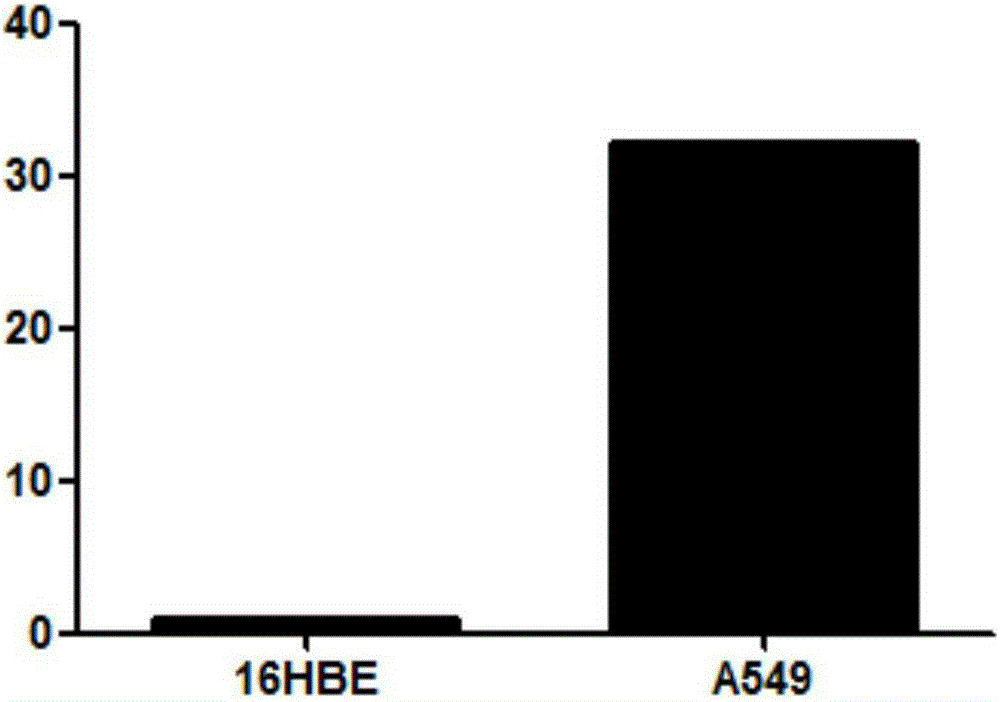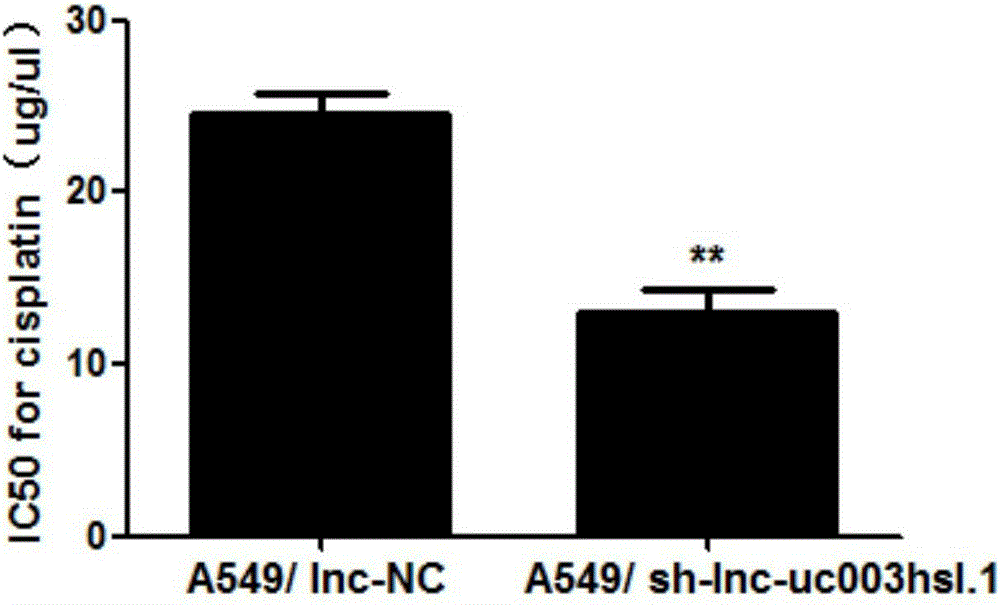Long non-coding RNA (Ribonucleic Acid) and application thereof
A non-coding, non-small cell lung cancer technology, applied in the application field of preparing drugs for the treatment of non-small cell lung cancer, can solve the problems of lost surgical opportunities, low survival rate, poor chemotherapy regimen for lung cancer, etc.
- Summary
- Abstract
- Description
- Claims
- Application Information
AI Technical Summary
Problems solved by technology
Method used
Image
Examples
Embodiment 1
[0054] Detection of the expression of lnc-uc003hsl.1 in tissues and cells
[0055] (1): The expression of lnc-uc003hsl.1 in normal lung tissue and lung cancer tissue:
[0056] 1. Chip preparation and analysis: Prepare normal lung tissue and lung cancer tissue samples according to the requirements of Boao Company in China, and submit them to Boao Company for chip preparation. The human long-chain non-coding RNA chip V1.0 version completed chip analysis, which contains the latest versions of many LncRNAs databases and tens of thousands of probes for LncRNAs detection. The detection principle of the chip is based on the length and structural characteristics of the lncRNA sequence, using a combination of random primers and Ologo(dT) reverse transcription to introduce the T7 promoter, and then amplifying the RNA by in vitro transcription-mediated linear amplification , RNA linear amplification method for sample labeling in microarray chip analysis. The DNA obtained by reverse tr...
Embodiment 2
[0074] Construct lnc-uc003hsl.1 lentiviral interference vector to transfect cells:
[0075] Design a specific interfering sequence against lnc-uc003hsl.1, its sequence is (5'to3'): CCAGATGGGCACTTCTAAA, see SeqNO.2, take the sequence fragment interfering with the GAPDH gene as a control, and insert it into the lentiviral vector ( The above vectors and fragments were synthesized by Invitrogen Company). The packaged lentiviral vector was used to infect the non-small cell lung cancer cell line A549 to down-regulate the expression of lnc-uc003hsl.1. After 48 hours, the stably transfected cell line was screened with G418 and named A549 / sh-lnc-uc003hsl. 1 (control is A549 / lnc-NC).
Embodiment 3
[0077] MTT method to detect cell proliferation:
[0078] 1) Cell inoculation: Digest monolayer cultured cells with 0.25% trypsin, prepare a single A549 / sh-lnc-uc003hsl.1 (control is A549 / lnc-NC) cell suspension with 1640 culture medium containing 10% fetal bovine serum 2500 cells per well were inoculated in a 96-well culture plate with a volume of 200ul per well. DDP (cisplatin, purchased from Jiangsu Hengrui Medicine Co., Ltd.) or DTX (docetaxel, purchased from Jiangsu Hengrui Medicine Co., Ltd.) were administered respectively.
[0079] 2) Culture cells: move the culture plate into CO 2In an incubator at 37°C, 5% CO 2 and relative humidity conditions for 3 days.
[0080] 3) Color development: After 6h, 24h, 48h, 72h, and 96h of culture, add 20ul of MTT solution (5mg / ml) to each well, continue to incubate at 37°C for 4h, terminate the culture, and carefully discard the culture supernatant in the well. Add 150 μl DMSO (dimethyl sulfoxide) and shake for 10 min to fully disso...
PUM
 Login to View More
Login to View More Abstract
Description
Claims
Application Information
 Login to View More
Login to View More - R&D
- Intellectual Property
- Life Sciences
- Materials
- Tech Scout
- Unparalleled Data Quality
- Higher Quality Content
- 60% Fewer Hallucinations
Browse by: Latest US Patents, China's latest patents, Technical Efficacy Thesaurus, Application Domain, Technology Topic, Popular Technical Reports.
© 2025 PatSnap. All rights reserved.Legal|Privacy policy|Modern Slavery Act Transparency Statement|Sitemap|About US| Contact US: help@patsnap.com



